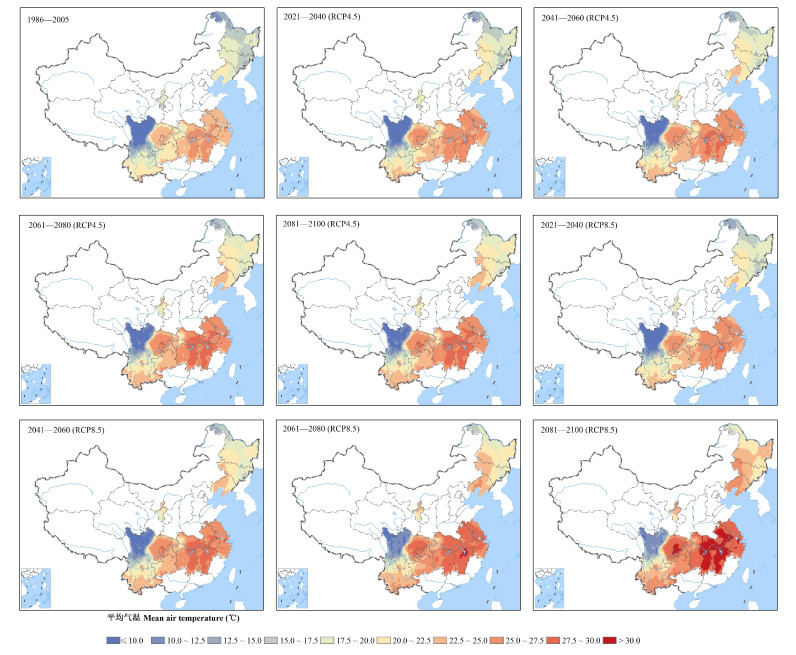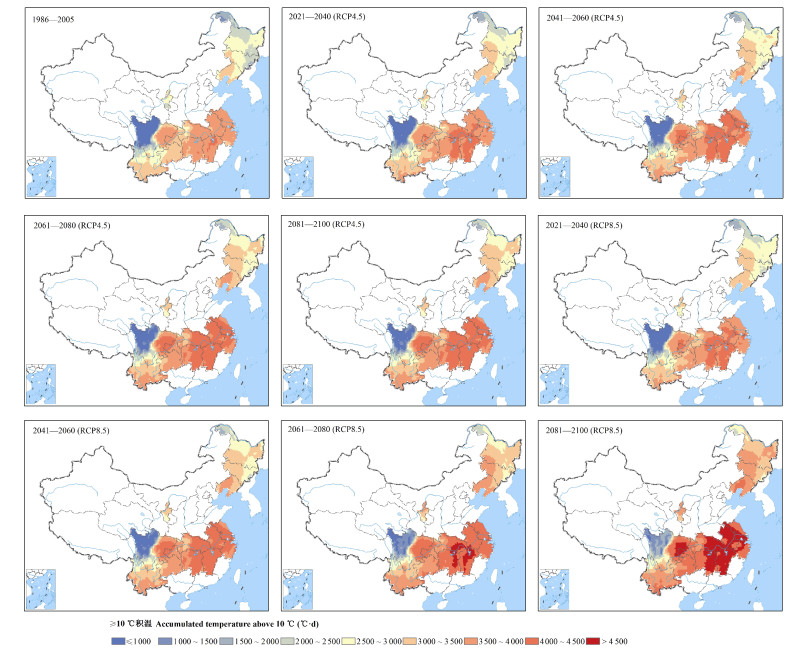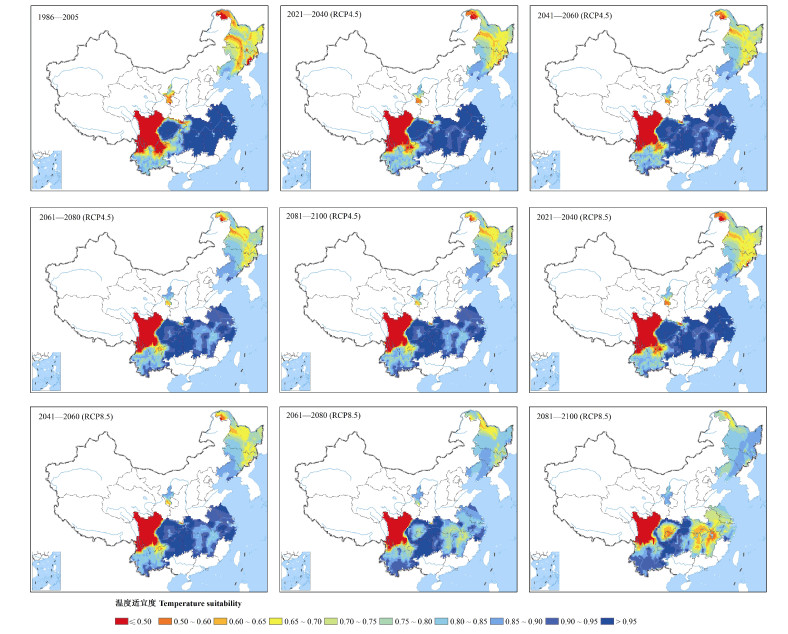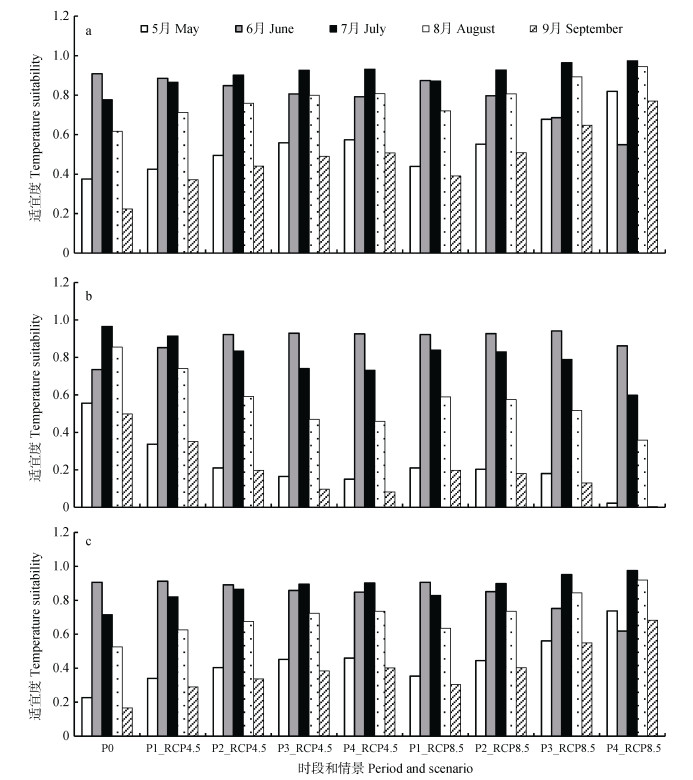IPCC最新发布的《气候变化与土地》特别报告(SRCCL)指出, 目前观测到的气候变化已经对全球粮食安全产生了影响, 其中亚洲、非洲、南美洲及地中海干旱地区尤为明显; 预计未来气候变化将持续加剧影响粮食安全, 将有约1.8亿人面临饥饿的风险[1]。目前, 气候变化影响与气候变化适应之间的差距主要表现在气候服务、作物和牲畜的遗传特征、气候影响模型、对极端事件的恢复力等[2], 因此评估气候变化及其影响, 尤其是气候变化对农业的影响仍需重点关注。水稻(Oryza sativa)作为中国三大粮食作物之一, 其总产量占世界水稻总产量的30%[3], 包括双季早稻、双季晚稻和一季稻。根据国家统计局水稻生产数据统计, 1986年以来全国一季稻种植面积、产量分别占稻谷总种植面积、产量的51.4%、57.1%, 且近年来呈逐步增加的态势。充分利用有效的气候资源, 确保水稻稳产、高产、高品质以应对气候变化, 关系粮食安全和社会经济稳定。
气候变化会引起水稻气候资源变化, 尤其是导致热量资源的质量和年际特点发生变化。伴随着气候变化引起的水稻热量资源的变化, 决定了水稻生长布局和结构[4-7], 其分布特征、种植布局、种植方式和品种已经出现了相应的变化[8-12]。在评价热量资源时, 多选用农业界限温度、积温、生长季长度等指标[13-14], 也有考虑水稻不同生长阶段生育特性的温度适宜度指数, 上述要素在气候变化背景下已经表现出不同的时空变化特点[15-18]。已有气候变化对水稻生产造成的影响已经被广泛认可, 而未来气候变化对水稻生产的风险将可能增大[19-20]。目前的研究多着眼于不同温室气体排放情景, 预估未来气候变化对不同典型区域水稻热量资源、气候资源和产量等产生的可能影响[21-25], 而从全国不同产区尺度的热量资源评估较少, 针对不同产区本身的特点及其区域差异的特点分析尚有欠缺。当然, 未来气候变化对地区水稻热量资源影响的预测存在不可避免的不确定性。在应对未来气候变化对水稻热量资源的影响研究中, 重要的一项工作就是减小气候变化影响评估的不确定性, 迫切需要减小未来温室气体排放情景的不确定性、改进影响评估方法[20]; 其中采用最新的温室气体排放情景、高分辨率的气候情景、多模式预测数据的集合是减小不确定性的一些主要手段。因此, 本文着眼于全国一季稻产区, 基于20个经过统计降尺度的高分辨率气候模式预估数据, 考虑两种温室气体排放情景(RCP4.5和RCP8.5), 以平均气温、≥10 ℃积温和温度适宜度作为一季稻热量资源指数, 分析全国一季稻热量资源未来动态变化特征, 以期为制定区域区别化的应对策略、进一步挖掘水稻生产潜力提供科学依据。
1 材料与方法 1.1 数据来源本文研究区针对全国主要一季稻主产区, 包括东北、西北地区东北部、长江中下游和西南地区。所用的气候情景资料来源于耦合模式比较计划第5阶段(CMIP5)的20个全球气候模式(global climate models, GCMs), 具体信息见表 1。GCM数据包括1961—2005年以及RCP4.5和RCP8.5情景下2006—2100年的逐日温度。
| 表 1 全球气候模式基本信息 Table 1 Basic information of global climate models |
由表 1可以看出, 不同GCM的分辨率差异较大且普遍在1.0°×1.0°以上, 较粗分辨率的数据不足以满足本研究的精细化需求。因此, 利用统计降尺度方法Bias Correction Spatial Disaggregation (BCSD)对GCMs的温度数据进行降尺度, 以观测的格点数据集(CN05)为参照数据, 通过去除趋势、mapping quantile偏差订正和空间聚散3个步骤, 最后得到高分辨率(0.25°×0.25°)的逐日温度数据。通过前期工作开展的对比订正前后的20个GCMs的温度模拟值与观测值, 可以看出降尺度后的模式温度数据精度较高[26], 能够满足研究需求。同时, 为了减小模式间的不确定性, 在对全国一季稻产区热量资源分析时采用20个GCMs集合平均的方式[25, 27-28]开展分析。
1.2 热量资源评价指标在一季稻主要生长季(5—9月), 以平均气温评估其平均态热量资源; ≥10 ℃积温可以反映和区分一季稻品种特性[21], 亦可作为热量资源的评价指标。
光、热、水资源是农业气候资源中3个最基本的要素, 它们为作物提供生长必需的物质和能量。各农业气候资源要素对作物的生长都存在一定的适宜范围, 可以采用模糊数学的方法, 将资源要素对作物生长发育的适宜程度定义到[0, 1], 继而可以用统一的量化指标来表示气候资源要素对作物生长的适宜度。因而, 温度对一季稻生长的适宜水平可以通过构建温度适宜度模型来评价:
| $ S(T) = \frac{{({T_i} - {T_l}){{({T_h} - {T_i})}^b}}}{{({T_o} - {T_l}){{({T_h} - {T_o})}^b}}} $ | (1) |
式中: S(T)为温度适宜度, Ti为某阶段平均气温, Th、Tl和To分别为一季稻某生长阶段适宜生长的最高温度、最低温度和最适温度, 不同地区针对地区特点厘定不同的温度临界值[9, 29-30], 具体取值见表 2。其中东北和西北地区5—9月一季稻分别处于播种育秧—移栽、返青—分蘖、分蘖—孕穗、抽穗—乳熟、成熟期, 西南处于播期育秧、分蘖、孕穗—抽穗、乳熟、成熟期, 长江中下游处于播期育秧、移栽返青、分蘖、孕穗—抽穗、乳熟—成熟期; b为温度反映系数。
| $ b = \frac{{{T_h} - {T_o}}}{{{T_o} - {T_l}}} $ | (2) |
| 表 2 不同地区一季稻生长季不同月份温度临界值(最低, 最高, 最适温度) Table 2 Typical values of temperature at different months of single-season rice season in different regions (minimum temperature, maximum temperature, optimal temperature) |
本文以1986—2005年作为基准时段, 将未来时段划分为2021—2040年、2041—2060年、2061—2080年、2081—2100年共4个时段, 考虑RCP4.5(中等排放)和RCP8.5(高排放)两种温室气体排放情景, 分析全国一季稻潜在热量资源的时空动态变化特征。
2 结果与分析 2.1 平均气温变化特征1986—2005年, 一季稻主要生长季内东北和宁夏地区平均气温大部为15.0~20.0 ℃, 西南地区南部和辽宁西部为20.0~22.5 ℃, 四川盆地、长江中下游地区普遍在22.5 ℃以上, 江西、湖南东部、湖北东部等地达25.0~27.5 ℃(图 1)。

|
图 1 不同情景下不同时段一季稻区5—9月平均气温 Fig. 1 Mean air temperature during May to September in different periods of time across the single-season rice area of China under RCP4.5 and RCP8.5 scenarios |
RCP4.5情景下, 从1986—2005年到2021—2040年、2041—2060年和2061—2080年时段, 大部地区平均气温呈升高趋势; 2081—2100年和2061—2080年较为接近。2081—2100年, 东北、宁夏大部普遍为17.5~25.0 ℃, 西南地区南部为20.0~25.0 ℃, 四川盆地和长江中下游地区为25.0~30.0 ℃。与RCP4.5情景相比, RCP8.5情景下不同时段平均气温的增幅更为明显; 2081—2100年, 东北和宁夏地区为20.0~27.5 ℃, 西南地区南部为22.5~27.5 ℃, 四川盆地和长江中下游地区在25.0 ℃以上, 其中江西、湖南东部、湖北中东部、安徽中部等地在30.0 ℃以上。可见, 未来气候情景下, 一季稻生长季内热量将增多。
2.2 ≥10 ℃积温变化特征一季稻主要生长季内, ≥10 ℃积温区域特征明显。1986—2005年, 东北和宁夏地区积温为2 000~ 3 500 ℃·d, 西南地区中南部为2 500~3 500 ℃·d, 四川盆地和长江中下游地区为3 500~4 000 ℃·d(图 2)。

|
图 2 不同情景下不同时段一季稻区5—9月≥10 ℃活动积温 Fig. 2 Accumulated temperature above 10 ℃ during May-September in different periods of time across the single-season rice area of China under RCP4.5 and RCP8.5 scenarios |
RCP4.5情景下, 不同时段≥10 ℃积温呈明显增加趋势(图 2); 至2081—2100年, 东北和宁夏地区为2 500~4 000 ℃·d, 西南地区中南部为3 000~ 4 000 ℃·d, 四川盆地和长江中下游地区达4 000~ 4 500 ℃·d。RCP8.5情景下, ≥10 ℃积温的增幅更加明显, 2081—2100年东北、宁夏和西南地区中南部为3 000~4 000 ℃·d, 四川盆地和长江中下游地区在4 000 ℃·d甚至4 500 ℃·d以上。积温的增加总体将利于一季稻品种由早中熟向中晚熟调整。
2.3 温度适宜度变化特征一季稻主要生长季内, 不同区域温度适宜度差异明显。1986—2005年, 东北地区温度适宜度呈现从南往北减小的分布形式, 辽宁西部和南部为0.80~0.90, 黑龙江西北部为0.50~0.60;宁夏从南往北增加, 从0.50~0.65增加到0.75~0.85;西南地区南部和东南部为0.70~0.85, 四川盆地和长江中下游地区在0.95以上(图 3)。RCP4.5情景下, 温度适宜度在不同时段呈现不同的变化趋势; 东北、宁夏、西南地区南部和东南部呈增大趋势, 而四川盆地和长江中下游地区呈减小趋势(图 3); 至2081—2100年, 东北、宁夏温度适宜度为0.65~0.90, 四川盆地和长江中下游地区为0.50~0.85, 西南地区南部和东南部在0.85以上。与RCP4.5情景相比, RCP8.5情景下温度适宜度在东北、宁夏、西南地区南部和东南部的增大趋势以及在四川盆地和长江中下游地区的减小趋势更为显著; 2081—2100年, 东北、宁夏温度适宜度为0.80~0.90, 四川盆地和长江中下游地区为0.50~0.85, 西南地区南部为0.90以上。

|
图 3 不同情景下不同时段一季稻区5—9月温度适宜度 Fig. 3 Temperature suitability during May-September in different periods of time across the single-season rice area of China under RCP4.5 and RCP8.5 scenarios |
1986—2005年, 大部地区温度适宜度呈增加趋势, 其中东北、宁夏、云南、贵州等地增加速率为0.01~0.05·(10a)-1, 长江中下游地区大部以-0.01~0 ·(10a)-1的速率下降(图 4)。RCP4.5情景下, 东北、宁夏、云南和贵州温度适宜度以0~0.03 ·(10a)-1的速率增加, 在长江中下游和四川盆地以-0.03~0 ·(10a)-1的速率下降; RCP8.5情景下, 温度适宜度的趋势特征更为明显, 东北、宁夏、云南和贵州以0~0.05 ·(10a)-1的速率增加, 在长江中下游和四川盆地以-0.11~-0.03 ·(10a)-1的速率下降。

|
图 4 不同情景下一季稻区5—9月温度适宜度的变化趋势 Fig. 4 Trend of temperature suitability during May-September across the single-season rice area of China under RCP4.5 and RCP8.5 scenarios |
以黑龙江、湖北、云南作为不同区域的代表(图 5), 进一步分析一季稻生长季各月的温度适宜度变化特征。1986—2005年, 黑龙江以6月的温度适宜度最高(0.91), 其次是7月、8月、5月和9月; 与1986—2005年相比, 在未来气候情景下, 6月份的温度适宜度呈一定的减小趋势, 而其余月份呈增加趋势, 且RCP8.5较RCP4.5更为明显, 到2081—2100时段不同月份的适宜度均在0.5以上。云南不同月份温度适宜度的变化特征与黑龙江相似, 6月温度适宜度呈减小趋势、而其余月份呈增加趋势; 与黑龙江相比, 云南温度适宜度略偏低, 但6月的减小幅度偏小、其余月份的增加幅度偏大。湖北温度适宜度变化特征与黑龙江和云南差异明显, 6月温度适宜度呈增加趋势、其余月份呈减小趋势, 总体上6月温度适宜度在较高水平(0.73~0.94), 但其增加幅度明显小于其余月份的减小幅度, 因而导致温度适宜度总体呈减小趋势。

|
图 5 不同月份黑龙江(a)、湖北(b)和云南(c)不同情景下的温度适宜度变化(P0、P1、P2、P3和P4分别代表1986—2005年、2021—2040年、2041—2060年、2061—2080年和2081—2100年) Fig. 5 Changes of monthly temperature suitability in Heilongjiang (a), Hubei (b) and Yunnan (c) during May-September under RCP4.5 and RCP8.5 scenarios (P0, P1, P2, P3 and P4 represent 1986-2005, 2021-2040, 2041-2060, 2061-2080 and 2081-2100, respectively) |
上述分析表明在未来气候情景下, 东北、宁夏、西南地区南部和东南部等地温度适宜度增大, 将利于一季稻生长, 其原因主要归因于平均气温和积温的增加利于一季稻生长发育。然而, 四川盆地和长江中下游地区温度适宜度呈现减小趋势, 可见温度升高并没有利于一季稻的生长。进一步分析长江中下游和四川盆地平均高温(最高温度≥35 ℃)日数变化(表 3)可以看出: 1986—2005年平均高温日数为5.29~7.64 d; 未来气候情景下, 高温日数明显增加, RCP4.5和RCP8.5情景下2081—2100年平均高温日数分别为24.89~34.08 d、55.92~68.62 d, 分别达1986—2005年的4倍和9倍以上, 显然高温日数的增加抑制了一季稻的生长, 从而导致温度适宜度的降低, 尤其是高温出现在水稻生长的中后期, 适宜度明显减小。
| 表 3 不同情景下不同地区一季稻生长季平均高温日数变化 Table 3 Change of days of heat stress during single-season rice season at different regions under RCP4.5 and RCP8.5 scenarios |
基于统计降尺度后的高分辨率GCMs的温度模拟数据, 本文着眼于未来时段, 分析了两种不同温室气体排放情景下全国不同一季稻产区平均气温、≥10 ℃积温和温度适宜度等热量资源特性的时空变化特征。总体上, RCP4.5和RCP8.5情景下, 未来平均气温、≥10 ℃积温呈增加的趋势, 这一结果与已有的部分区域的结论一致:如SRES(special report on emission scenarios)A2和B2情景下, 21世纪末四川省一季稻生育期内≥10 ℃积温呈增加的趋势[22]; RCP4.5和RCP8.5情景下, 21世纪中期长江中下游地区一季稻生育期内≥10 ℃积温呈明显增加[23]; RCP4.5情景下, 21世纪中期、后期东北地区≥10 ℃积温呈显著增加趋势[31]。由于不同地区气候特点的差异, 平均气温、≥10 ℃积温的增加幅度有所差异, 但一致性增加的趋势意味着未来将有更多的热量资源用以满足一季稻生长; 为了更好地利用增加的热量资源, 可以采用生育期更长的品种。当然, 平均温度和≥10 ℃积温的增加并不是说明热量资源就都利于一季稻的生长, 由于一季稻在生长过程中有其自身的温度需求, 温度过高、过低都会抑制生长发育[32-33], 未来情景下温度升高, 将减轻低温的影响, 但是部分区域可能遭受的高温胁迫将增加; 因此, 考虑一季稻生长适宜温度需求范围的温度适宜度作为另一个指标用来评估热量资源变化动态。在基准时段内, 适宜度总体呈增加的趋势, 这与已有的区域一季稻温度适宜度的空间分布特征及时间趋势较为一致[18, 29]; 温度适宜度的增加表明已有的气候变化利于一季稻生长。尽管总体趋势一致, 但是温度适宜度在区域间的差异较大, 其中四川盆地和长江中下游地区目前温度适宜度处于较高水平、但呈弱增加甚至减小的趋势, 而其他地区适宜度仍处于增加趋势中。未来气候情景下, 四川盆地和长江中下游地区温度适宜度呈减小趋势, 可见未来变暖的条件对一季稻的适宜性在减弱, 其主要原因是未来一季稻生长将面临的高温热害风险将增加[28]。温度适宜度的这种变化趋势与已有针对区域的研究有差异, 如SRES A2情景下淮河流域一季稻温度适宜度呈现增加的趋势[15], 与本文得出的减小趋势不同; 两者不同之处在于气候情景和气候模式的选取上, 由于温室气体排放情景和模式本身的不确定, 不同模式的模拟效果及准确性区别较大, 区域上的差异更大, 因此有必要开展模式的模拟效果评估及偏差订正以选择模拟效果较好的模式[26], 以获取精度更好的结果。
通过选取经过偏差订正的高分辨率模式数据, 一季稻热量资源的动态变化特征主要表现为:与1986—2005年相比, RCP4.5和RCP8.5情景下, 未来时段大部地区平均气温、≥10 ℃积温和温度适宜度呈增加的趋势, 且RCP8.5较RCP4.5增幅更为明显; 东北、宁夏、西南地区南部和东南部等地未来热量资源增加, 将有利于一季稻生长; 而四川盆地和长江中下游地区尽管平均气温、≥10 ℃积温呈增加趋势, 但是温度适宜度呈减小趋势, 将对一季稻生长不利。考虑到不同区域的一季稻对气候变化的敏感性差异[34], 依据本文的结果可以为调整水稻生产提供因地制宜的指导作用, 如东北等地可以进一步采取生育期更长的中晚熟品种、长江中下游地区需要采取措施避开高温胁迫增加的影响, 以期更好地利用热量资源、提高一季稻产量。此外, 影响一季稻生长的因素除温度外, 还有降水、辐射等气象要素, 并非单一气候资源的增加速率越大越好, 而是多个气候资源相互有效协调[23], 因而多种资源的综合分析有待下一步深入分析, 以提高气候生产潜力、确保粮食安全。
| [1] |
MBOW C C, ROSENZWEIG L G, BARIONI T G, et al. Food Security. In Climate Change and Land: an IPCC Special Report on Climate Change, Desertification, Land Degradation, Sustainable Land Management, Food Security, and Greenhouse Gas Fluxes in Terrestrial Ecosystems[M]. 2019. https://www.ipcc.ch/site/assets/uploads/sites/4/2019/11/08_Chapter-5.pdf
|
| [2] |
许吟隆, 赵运成, 翟盘茂. IPCC特别报告SRCCL关于气候变化与粮食安全的新认知与启示[J]. 气候变化研究进展, 2020, 16(1): 37-49. XU Y L, ZHAO Y C, ZHAI P M. Advances in scientific understanding on climate change and food security from IPCC special report SRCCL[J]. Climate Change Research, 2020, 16(1): 37-49. |
| [3] |
FAO. Food and Agricultural Organization of the United Nations[EB/OL]. FAOSTAT, 2014. http://www.fao.org/faostat/en/#data/QC
|
| [4] |
段居琦, 周广胜. 中国水稻潜在分布及其气候特征[J]. 生态学报, 2011, 31(22): 6659-6668. DUAN J Q, ZHOU G S. Potential distribution of rice in China and its climate characteristics[J]. Acta Ecologica Sinica, 2011, 31(22): 6659-6668. |
| [5] |
LIU Z H, LI Z G, TANG P Q, et al. Change analysis of rice area and production in China during the past three decades[J]. Journal of Geographical Sciences, 2013, 23(6): 1005-1018. DOI:10.1007/s11442-013-1059-x |
| [6] |
吕伟生, 曾勇军, 石庆华, 等. 近30年江西双季稻安全生产期及温光资源变化[J]. 中国水稻科学, 2016, 30(3): 323-334. LYU W S, ZENG Y J, SHI Q H, et al. Changes in safe production dates and heat-light resources of double cropping rice in Jiangxi Province in recent 30 years[J]. Chinese Journal of Rice Science, 2016, 30(3): 323-334. |
| [7] |
罗怀良, 闫宁. 区域种植业气候适宜度及其对种植活动的响应——以四川省盐亭县为例[J]. 生态学报, 2016, 36(24): 7981-7991. LUO H L, YAN N. Study on climatic suitability for planting and effect of crop planting activities on climatic suitability:A case study of Yanting County, Sichuan Province, China[J]. Acta Ecologica Sinica, 2016, 36(24): 7981-7991. |
| [8] |
陈浩, 李正国, 唐鹏钦, 等. 气候变化背景下东北水稻的时空分布特征[J]. 应用生态学报, 2016, 27(8): 2571-2579. CHEN H, LI Z G, TANG P Q, et al. Rice area change in Northeast China and its correlation with climate change[J]. Chinese Journal of Applied Ecology, 2016, 27(8): 2571-2579. |
| [9] |
谢远玉, 黄淑娥, 田俊, 等. 长江中下游热量资源时空演变特征及其对双季稻种植的影响[J]. 应用生态学报, 2016, 27(9): 2950-2958. XIE Y Y, HUANG S E, TIAN J, et al. Spatial-temporal characteristics of thermal resources and its influence on the growth of double cropping rice in the middle and lower reaches of the Yangtze River, China[J]. Chinese Journal of Applied Ecology, 2016, 27(9): 2950-2958. |
| [10] |
杜尧东, 沈平, 王华, 等. 气候变化对广东省双季稻种植气候区划的影响[J]. 应用生态学报, 2018, 29(12): 4013-4021. DU Y D, SHEN P, WANG H, et al. Impacts of climate change on climatic division for double cropping rice in Guangdong Province, China[J]. Journal of Applied Ecology, 2018, 29(12): 4013-4021. |
| [11] |
刘维, 李祎君, 吕厚荃. 早稻抽穗开花至成熟期气候适宜度对气候变暖与提前移栽的响应[J]. 中国农业科学, 2018, 51(1): 49-59. LIU W, LI Y J, LYU H Q. Responses of heading to flowering to maturity of early rice to climate change and different transplant periods[J]. Scientia Agricultura Sinica, 2018, 51(1): 49-59. |
| [12] |
蒋敏, 李秀彬, 辛良杰, 等. 南方水稻复种指数变化对国家粮食产能的影响及其政策启示[J]. 地理学报, 2019, 74(1): 32-43. JIANG M, LI X B, XIN L J, et al. The impact of paddy rice multiple cropping index changes in southern China on national grain production capacity and its policy implications[J]. Acta Geographica Sinica, 2019, 74(1): 32-43. |
| [13] |
刘敏, 刘安国, 邓爱娟, 等. 湖北省水稻生长季热量资源变化特征及其对水稻生产的影响[J]. 华中农业大学学报, 2011, 30(6): 746-752. LIU M, LIU A G, DENG A J, et al. Changing characteristics of heat resources of rice growing seasons in Hubei Province and its impacts on rice production[J]. Journal of Huazhong Agricultural University, 2011, 30(6): 746-752. |
| [14] |
王水霞, 殷淑燕, 赵芮芮. 秦岭南部一季稻区水热条件变化时空特征分析[J]. 中山大学学报:自然科学版, 2018, 57(6): 17-28. WANG S X, YIN S Y, ZHAO R R. The spatial-temporal variations of climatic conditions in the single-season rice area in southern Qinling Mountains[J]. Acta Scientiarum Naturalium Universitatis Sunyatseni, 2018, 57(6): 17-28. |
| [15] |
赖纯佳, 千怀遂, 段海来, 等. 淮河流域小麦-水稻种植制度的气候适宜性[J]. 中国农业科学, 2011, 44(14): 2868-2875. LAI C J, QIAN H S, DUAN H L, et al. Climate suitability of wheat-rice double cropping system in Huaihe Watershed[J]. Scientia Agricultura Sinica, 2011, 44(14): 2868-2875. |
| [16] |
张建军, 马晓群, 许莹. 安徽省一季稻生长气候适宜性评价指标的建立与试用[J]. 气象, 2013, 39(1): 88-93. ZHANG J J, MA X Q, XU Y. Establishment and application of growing climatic suitability indicator of single cropping rice in Anhui Province[J]. Meteorological Monthly, 2013, 39(1): 88-93. |
| [17] |
武晋雯, 孙龙彧, 纪瑞鹏, 等. 辽宁水稻气候适宜度日尺度评价研究[J]. 资源科学, 2017, 39(8): 1605-1613. WU J W, SUN L Y, JI R P, et al. Intraday evaluation modeling of climatic suitability for rice in Liaoning Province[J]. Resources Science, 2017, 39(8): 1605-1613. |
| [18] |
谭方颖, 王建林, 程路. 东北地区单季稻温度适宜性及其变化特征[J]. 生态学杂志, 2017, 36(3): 719-724. TAN F Y, WANG J L, CHENG L. Temperature suitability of rice and its variation in Northeast China[J]. Chinese Journal of Ecology, 2017, 36(3): 719-724. |
| [19] |
IPCC. Climate Change 2014: Synthesis Report. Contribution of working groups Ⅰ, Ⅱ and Ⅲ to the Fifth Assessment Report of the Intergovernmental Panel on Climate Change[R]. Geneva, Switzerland: IPCC, 2014: 1-151
|
| [20] |
凌霄霞, 张作林, 翟景秋, 等. 气候变化对中国水稻生产的影响研究进展[J]. 作物学报, 2019, 45(3): 323-334. LING X X, ZHANG Z L, ZHAI J Q, et al. A review for impacts of climate change on rice production in China[J]. Acta Agronomica Sinica, 2019, 45(3): 323-334. |
| [21] |
江敏, 金之庆, 杨慧, 等. 福建省水稻生育期气温与降水的时空分布及其对稻作制度的影响[J]. 应用生态学报, 2012, 23(12): 3393-3401. JIANG M, JIN Z Q, YANG H, et al. Spatiotemporal distribution of air temperature and precipitation in rice growth period in Fujian Province of East China and the effects of this distribution on rice planting pattern[J]. Journal of Applied Ecology, 2012, 23(12): 3393-3401. |
| [22] |
庞艳梅, 陈超, 马振峰. 未来气候变化对四川省水稻生育期气候资源及生产潜力的影响[J]. 西北农林科技大学学报:自然科学版, 2015, 43(1): 58-68. PANG Y M, CHEN C, MA Z F. Impacts of future climate change on climatic resources and production potential during growth period of rice in Sichuan Province[J]. Journal of Northwest A & F University:Natural Science Edition, 2015, 43(1): 58-68. |
| [23] |
刘文茹, 陈国庆, 曲春红, 等. RCP情景下长江中下游麦稻二熟制气候生产潜力变化特征研究[J]. 生态学报, 2018, 38(1): 156-166. LIU W R, CHEN G Q, QU C H, et al. Variations in potential climatic productivity of wheat and rice in the middle and lower reaches of the Yangtze River under RCP scenarios[J]. Acta Ecologica Sinica, 2018, 38(1): 156-166. |
| [24] |
ZHANG L, YANG B Y, LI S, et al. Assessing multi-risk characteristics of heat and cold stress for rice across the southern parts of China[J]. International Journal of Biometeorology, 2019, 63(12): 1597-1609. DOI:10.1007/s00484-019-01772-4 |
| [25] |
张学珍, 李侠祥, 张丽娟, 等. RCP8.5气候变化情景下21世纪印度粮食单产变化的多模式集合模拟[J]. 地理学报, 2019, 74(11): 2314-2328. ZHANG X Z, LI X X, ZHANG L J, et al. Multi-model ensemble projection of crop yield of India under RCP 8.5 climate change scenario during the 21st century[J]. Acta Geographica Sinica, 2019, 74(11): 2314-2328. |
| [26] |
ZHANG L, XU Y L, MENG C C, et al. Comparison of statistical and dynamic downscaling techniques in generating high-resolution temperatures in China from CMIP5 GCMs[J]. Journal of Applied Meteorology and Climatology, 2020, 59(2): 207-235. |
| [27] |
HUANG D P, ZHANG L, GAO G, et al. Projected changes in population exposure to extreme heat in China under a RCP8.5 scenario[J]. Journal of Geographical Sciences, 2018, 28(10): 1371-1384. DOI:10.1007/s11442-018-1550-5 |
| [28] |
ZHANG L, YANG B Y, LI S, et al. Potential rice exposure to heat stress along the Yangtze River in China under RCP8.5 scenario[J]. Agricultural and Forest Meteorology, 2018, 248: 185-196. DOI:10.1016/j.agrformet.2017.09.020 |
| [29] |
唐余学, 范莉, 阳园燕, 等. 中稻生育期气象适宜度及其对产量影响的定量评价模型构建和应用[J]. 西南师范大学学报:自然科学版, 2014, 39(3): 136-142. TANG Y X, FAN L, YANG Y Y, et al. On construction and application of quantitative evaluation model of meteorological suitability and its effect on yield for medium rice in its growth period[J]. Journal of Southwest China Normal University:Natural Science Edition, 2014, 39(3): 136-142. |
| [30] |
俞芬, 千怀遂, 段海来. 淮河流域水稻的气候适宜度及其变化趋势分析[J]. 地理科学, 2008, 28(4): 537-542. YU F, QIAN H S, DUAN H L. Climate suitability of rice and its changes in Huaihe Watershed[J]. Scientia Geographica Sinica, 2008, 28(4): 537-542. |
| [31] |
LI X H, XU Y L, MENG C C, et al. Analysis on the changes of agro-meteorological thermal indices in Northeast China under RCP4.5 scenario using the PRECIS2.1[J]. Atmosphere, 2018, 9: 323. DOI:10.3390/atmos9080323 |
| [32] |
HUANG M, JIANG J G, ZOU Y B, et al. On-farm assessment of effect of low temperature at seedling stage on early-season rice quality[J]. Field Crops Research, 2013, 141: 63-68. DOI:10.1016/j.fcr.2012.10.019 |
| [33] |
JULIA C, DINGKUHN M. Predicting temperature induced sterility of rice spikelets requires simulation of crop-generated microclimate[J]. European Journal of Agronomy, 2013, 49: 50-60. DOI:10.1016/j.eja.2013.03.006 |
| [34] |
熊伟, 杨婕, 吴文斌, 等. 中国水稻生产对历史气候变化的敏感性和脆弱性[J]. 生态学报, 2013, 33(2): 509-518. XIONG W, YANG J, WU W B, et al. Sensitivity and vulnerability of China's rice production to observed climate change[J]. Acta Ecologica Sinica, 2013, 33(2): 509-518. |
 2020, Vol. 28
2020, Vol. 28


